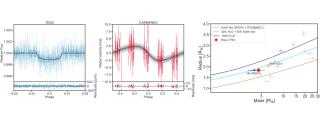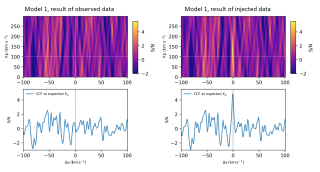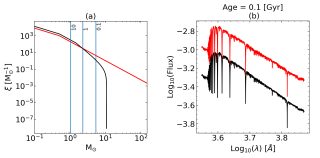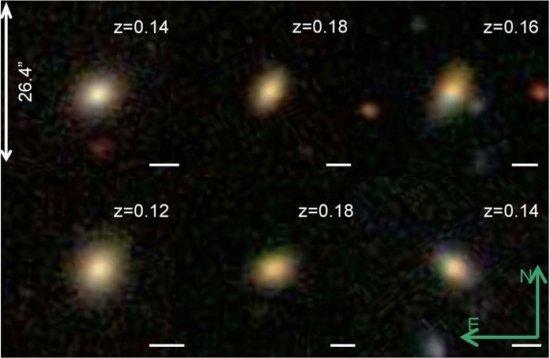El descubrimiento de que las galaxias mas masivas eran mucho mas compactas en el pasado que las galaxias que tienen igual masa hoy, representa uno de los mayores retos para los escenarios actuales que describen la formacion de las galaxias. Una de las ideas que se han sugerido es que estas galaxias compactas se han ido transformado con el tiempo en los núcleos de las galaxias mas masivas que vemos hoy en dia. Nuestro grupo ha llevado a cabo dos estudios paralelos para por un lado tratar de identificar galaxias masivas y compactas que pudieran haber sobrevivido intactas desde su formación inicial y por lo tanto estudiar sus propiedades y otro estudio para explorar la evolución estructural y dinámica de estos objetos a medida que el tiempo transcurre. Hemos encontrado que hoy en dia la poblacion de galaxias masivas y compactas es extremadamente pequeña (<0.03% de las galaxias masivas) y sorprendentemente son objetos relativamente jovenes. Estos resultados sugieren que las galaxias mas masivas se forman siempre de manera compacta y luego evolucionan hasta formar la poblacion actual. Ademas, este analisis nos indica que la evolucion de estos objetos compactos y lejanos debe ser muy rapida pues ya no es posible encontrar ninguno de estas galaxias en la actualidad. Por otro lado, nuestro análisis de la evolución dinamica de los objetos mas masivos es compatible con un escenario donde el halo de materia oscura ya estaba formado en el pasado y el enorme crecimiento observado en tamaño de estos objetos solo se ha producido en la distribución de sus estrellas. En conjunto, nuestros resultados parecen indicar que estas galaxias masivas se formaron en un estallido muy intenso de formación estelar y luego han evolucionado hasta convertirse en el nucleo de las galaxias mas masivas del universo cercano a traves de la acrecion de otras galaxias satelites mas pequeñas.
Advertised on
References
Trujillo, I. et al. (2009). ApJL 692, 118
It may interest you
-
 The TESS (Transiting Exoplanet Survey Satellite) mission has discovered many exoplanet candidates that need to be confirmed and characterized from the ground. One of them orbits Ross 176, a K-type dwarf star, where we have identified a promising hot “water-world” candidate. Using spectroscopic observations with the CARMENES instrument, we confirmed the planetary nature of the signal detected by TESS and estimated the planet’s mass. To improve the analysis, we applied an advanced statistical method called Gaussian Process, which allowed us to separate the star’s own variability (quite strongAdvertised on
The TESS (Transiting Exoplanet Survey Satellite) mission has discovered many exoplanet candidates that need to be confirmed and characterized from the ground. One of them orbits Ross 176, a K-type dwarf star, where we have identified a promising hot “water-world” candidate. Using spectroscopic observations with the CARMENES instrument, we confirmed the planetary nature of the signal detected by TESS and estimated the planet’s mass. To improve the analysis, we applied an advanced statistical method called Gaussian Process, which allowed us to separate the star’s own variability (quite strongAdvertised on -
 The rocky planet GJ 1132 b, with Earth-like mass and radius, is a prime candidate for atmospheric studies. Previous observations with Hubble and JWST yielded conflicting results about its atmosphere. This study used three transit observations with the CRIRES+ instrument to search for He i, HCN, CH₄, and H₂O in GJ 1132 b's atmosphere. No clear atmospheric signals were detected, but upper limits for CH₄, HCN, and H₂O were established. The results suggest that if GJ 1132 b has an atmosphere, it is not dominated by hydrogen. The work highlights the challenges of detecting high molecular weightAdvertised on
The rocky planet GJ 1132 b, with Earth-like mass and radius, is a prime candidate for atmospheric studies. Previous observations with Hubble and JWST yielded conflicting results about its atmosphere. This study used three transit observations with the CRIRES+ instrument to search for He i, HCN, CH₄, and H₂O in GJ 1132 b's atmosphere. No clear atmospheric signals were detected, but upper limits for CH₄, HCN, and H₂O were established. The results suggest that if GJ 1132 b has an atmosphere, it is not dominated by hydrogen. The work highlights the challenges of detecting high molecular weightAdvertised on -
 We present, for the first time, model spectra of single-age, single-metallicity stellar populations computed with the E-MILES evolutionary synthesis code incorporating an environment-dependent, variable galaxy-wide initial mass function (gwIMF). This gwIMF, calculated using the GalIMF code, is rooted in the integrated galactic initial mass function (IGIMF) theory, which predicts IMF variations as a function of the star formation rate and the metallicity. By coupling these two codes, we generated a comprehensive library of single-burst stellar population spectra uniquely sensitive to gwIMFAdvertised on
We present, for the first time, model spectra of single-age, single-metallicity stellar populations computed with the E-MILES evolutionary synthesis code incorporating an environment-dependent, variable galaxy-wide initial mass function (gwIMF). This gwIMF, calculated using the GalIMF code, is rooted in the integrated galactic initial mass function (IGIMF) theory, which predicts IMF variations as a function of the star formation rate and the metallicity. By coupling these two codes, we generated a comprehensive library of single-burst stellar population spectra uniquely sensitive to gwIMFAdvertised on
